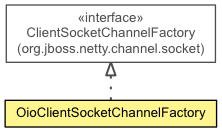
- java.lang.Object
-
- org.jboss.netty.channel.socket.oio.OioClientSocketChannelFactory
-
- All Implemented Interfaces:
- ChannelFactory, ClientSocketChannelFactory, ExternalResourceReleasable
public class OioClientSocketChannelFactory extends Object implements ClientSocketChannelFactory
AClientSocketChannelFactorywhich creates a client-side blocking I/O basedSocketChannel. It utilizes the good old blocking I/O API which is known to yield better throughput and latency when there are relatively small number of connections to serve.How threads work
There is only one type of threads in
OioClientSocketChannelFactory; worker threads.Worker threads
Each connected
Channelhas a dedicated worker thread, just like a traditional blocking I/O thread model.Life cycle of threads and graceful shutdown
Worker threads are acquired from the
Executorwhich was specified when aOioClientSocketChannelFactorywas created (i.e.workerExecutor.) Therefore, you should make sure the specifiedExecutoris able to lend the sufficient number of threads.Worker threads are acquired lazily, and then released when there's nothing left to process. All the related resources are also released when the worker threads are released. Therefore, to shut down a service gracefully, you should do the following:
- close all channels created by the factory usually using
ChannelGroup.close(), and - call
releaseExternalResources().
RejectedExecutionExceptionand the related resources might not be released properly.Limitation
A
SocketChannelcreated by this factory does not support asynchronous operations. Any I/O requests such as"connect"and"write"will be performed in a blocking manner.
-
-
Constructor Summary
Constructors Constructor and Description OioClientSocketChannelFactory()Creates a new instance with aExecutors.newCachedThreadPool()as worker executor.OioClientSocketChannelFactory(Executor workerExecutor)Creates a new instance.OioClientSocketChannelFactory(Executor workerExecutor, ThreadNameDeterminer determiner)Creates a new instance.
-
Method Summary
Methods Modifier and Type Method and Description SocketChannelnewChannel(ChannelPipeline pipeline)voidreleaseExternalResources()Releases the external resources that this factory depends on to function.voidshutdown()Shudown the ChannelFactory and all the resource it created internal.
-
-
-
Constructor Detail
-
OioClientSocketChannelFactory
public OioClientSocketChannelFactory()
Creates a new instance with aExecutors.newCachedThreadPool()as worker executor. SeeOioClientSocketChannelFactory(Executor)
-
OioClientSocketChannelFactory
public OioClientSocketChannelFactory(Executor workerExecutor)
Creates a new instance.- Parameters:
workerExecutor- theExecutorwhich will execute the I/O worker threads
-
OioClientSocketChannelFactory
public OioClientSocketChannelFactory(Executor workerExecutor, ThreadNameDeterminer determiner)
Creates a new instance.- Parameters:
workerExecutor- theExecutorwhich will execute the I/O worker threadsdeterminer- theThreadNameDeterminerto set the thread names.
-
-
Method Detail
-
newChannel
public SocketChannel newChannel(ChannelPipeline pipeline)
Description copied from interface:ChannelFactory- Specified by:
newChannelin interfaceChannelFactory- Specified by:
newChannelin interfaceClientSocketChannelFactory- Parameters:
pipeline- theChannelPipelinewhich is going to be attached to the newChannel- Returns:
- the newly open channel
-
shutdown
public void shutdown()
Description copied from interface:ChannelFactoryShudown the ChannelFactory and all the resource it created internal.- Specified by:
shutdownin interfaceChannelFactory
-
releaseExternalResources
public void releaseExternalResources()
Description copied from interface:ChannelFactoryReleases the external resources that this factory depends on to function. An external resource is a resource that this factory didn't create by itself. For example,Executors that you specified in the factory constructor are external resources. You can call this method to release all external resources conveniently when the resources are not used by this factory or any other part of your application. An unexpected behavior will be resulted in if the resources are released when there's an open channel which is managed by this factory. This will also callChannelFactory.shutdown()before do any action- Specified by:
releaseExternalResourcesin interfaceChannelFactory- Specified by:
releaseExternalResourcesin interfaceExternalResourceReleasable
-
-